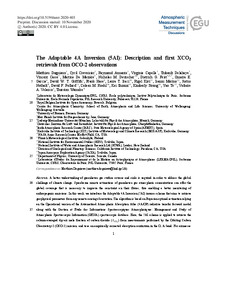Por favor, use este identificador para citar o enlazar este ítem:
http://hdl.handle.net/20.500.11765/12579
The Adaptable 4A Inversion (5AI): Description and first XCO2 retrievals from OCO-2 observations [Discussion paper]
| Título : | The Adaptable 4A Inversion (5AI): Description and first XCO2 retrievals from OCO-2 observations [Discussion paper] |
| Autor : | Dogniaux, Matthieu; Crevoisier, Cyril; Armante, Raymond; Capelle, Virginie; Delahaye, Thibault; Cassé, Vincent; De Mazière, Martine; Deutscher, Nicholas Michael; Feist, Dietrich G.; García Rodríguez, Omaira Elena



|
| Palabras clave : | Greenhouse gases; Climate change; Remote sensing; Carbon dioxide |
| Fecha de publicación : | 2020 |
| Editor: | European Geosciences Union |
| Citación : | Atmospheric Measurement Techniques Discussions. 2020 |
| Versión del editor: | https://dx.doi.org/10.5194/amt-2020-403 |
| Resumen : | A better understanding of greenhouse gas surface sources and sinks is required in order to address the global challenge of climate change. Spaceborne remote estimations of greenhouse gas atmospheric concentrations can offer the global coverage that is necessary to improve the constraint on their fluxes, thus enabling a better monitoring of anthropogenic emissions. In this work, we introduce the Adaptable 4A Inversion (5AI) inverse scheme that aims to retrieve geophysical parameters from any remote sensing observation. The algorithm is based on Bayesian optimal estimation relying on the Operational version of the Automatized Atmospheric Absorption Atlas (4A/OP) radiative transfer forward model along with the Gestion et Étude des Informations Spectroscopiques Atmosphériques: Management and Study of Atmospheric Spectroscopic Information (GEISA) spectroscopic database. Here, the 5AI scheme is applied to retrieve the column-averaged dry-air mole fraction of carbon dioxide (XCO2) from measurements performed by the Orbiting Carbon Observatory-2 (OCO-2) mission, and uses an empirically corrected absorption continuum in the O2 A-band. For airmasses below 3.0, XCO2 retrievals successfully capture the latitudinal variations of CO2, as well as its seasonal cycle and long-term increasing trend. Comparison with ground-based observations from the Total Carbon Column Observing Network (TCCON) yields a difference of 1.33 ± 1.29 ppm, which is similar to the standard deviation of the Atmospheric CO2 Observations from Space (ACOS) official products. We show that the systematic differences between 5AI and ACOS results can be fully removed by adding an average calculated – observed spectral residual correction to OCO-2 measurements, thus underlying the critical sensitivity of retrieval results to forward modelling. These comparisons show the reliability of 5AI as a Bayesian optimal estimation implementation that is easily adaptable to any instrument designed to retrieve column-averaged dry-air mole fractions of greenhouse gases. |
| Patrocinador: | This work has received funding from CNES and CNRS. |
| URI : | http://hdl.handle.net/20.500.11765/12579 |
| ISSN : | 1867-8610 |
| Colecciones: | Artículos científicos 2019-2022 |
Ficheros en este ítem:
| Fichero | Descripción | Tamaño | Formato | ||
|---|---|---|---|---|---|
| amt-2020-403.pdf | 12,84 MB | Adobe PDF |  Visualizar/Abrir |
Los ítems de Arcimis están protegidos por una Licencia Creative Commons, salvo que se indique lo contrario.





